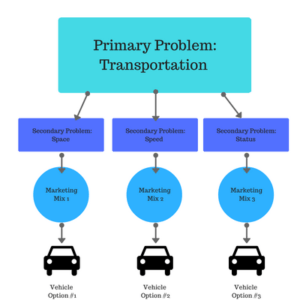This may have happened to you.
You see a promotion or an advertisement that seems to “read your mind”. You instantly resonate with the message. But you might completely skip the content of a rival brand that serves similar pain points.
Why do some products instantly appeal to us? While other offerings never register on our radars?
The reason behind this is the effective execution of a strategy called market segmentation.
Developed back in the 1950s, market segmentation is based on the understanding that a solution can’t be everything to everyone.
A product is bound to have features that solve certain pain points better than others. This ability makes the offering attractive to groups of prospective buyers who are grappling with the problems it eliminates. These people have similar motivations and desires and are easy to cluster together.
It is in the best interest of companies to identify such segments that are favorably disposed towards their products and spend their advertising budget reaching out to them.
Through this article, I will explore the importance of market segmentation, the different types of segmentation strategies, the process of coming up with a segment and some challenges involved.
What is Market Segmentation or Customer Segmentation?
The classic definition of market or customer segmentation is “dividing a broad and heterogeneous market comprising of prospective customers with several different types of preferences, pain points and varied buying capacities into smaller homogenous sub-groups on the basis of perceived commonalities of age, gender, location, income, interests, problems and cultural backgrounds so that grabbing their attention with one marketing message is easier”
A great example of market segmentation in action is the automobile industry. Everyone needs a car to travel back and forth. But if getting from one place to another is the only “requirement” on the basis of which companies promote their products, then why are there so many different makes, models and versions – often from one single brand?

It is because buyers primarily want private and convenient transportation. But beyond this pain point there are several other considerations that come into play. Some wish to own a large and spacious car to accommodate family members who tend to travel together.
Some might want vehicles with more horse power and speed because time is of the essence in their schedule. Still others buy a car as a status symbol. Such customers can be lured with the promise of a luxury acquisition that their peers can’t rival.
Automobile companies are masters at spotting and leveraging these differences.
When you think of the Volkswagen Polo the attributes robust, affordable and hatchback come to mind. But do you know that the Volkswagen group owns Audi, Lamborghini and the Porsche among others? Brands that stand for glamor, a jet-setting life style and exclusivity!
Volkswagen has several different “personas” for different client groups. It may come across as reliable to some and elite to others. It has aced the science of clustering buyers with similar needs and creates a focused marketing mix for each cluster to position its vehicles as the best option in the market.
Why is Market Segmentation so Important?
Market segmentation is inevitably followed by targeting and positioning. The three concepts are the backbone of a profitable marketing campaign. If a company fails at segmentation, it also impacts the subsequent steps of targeting and positioning.
It is thus critical to the success of a product to get market segmentation right.
Market Segmentation Improves ROI
Imagine pitching a product to the entire market. This is known as the mass marketing method. The only channels that are expansive enough to cover all possible buyer groups are television and print media. And they are quite expensive. Through segmentation and refined targeting, companies can choose clusters of prospects that are:
- Considerable in size
- Pre-disposed or favorably disposed towards the product and thus easy to convert
These two criteria ensure quick wins for brands. The return on investment (ROI) is obviously higher because niche driven promotional channels like certain social media platforms and forums are more cost effective and the overall approach is less labor intensive. Capgemini has bumped returns for an international retailer through its cutting edge segmentation experiment with digital signage where boards display messages based on what the buyer’s group (or segment) is proven to like. Market segmentation gives companies the ability to focus on what will work in a more intense and streamlined way.
Market Segmentation Reinforces Brand Personality & Triggers Recall
Let’s get into psychographics here for a moment. The analysis that is needed to gather sufficient data and segment markets also yields “gold” in terms of buyer motivations, the stories they tell themselves about their problems and the promised benefits they would love to realize. Taking these ingredients together brands create extremely specific promotions and advertisements that have a high relatability factor and can trigger recall.
Cheetos used fMRI scans to identify why their snack pleased buyers as a re-segmentation exercise. The result was rather surprising. It seemed that customers enjoyed the mess that the orange powder from the sticks left because the act of dirtying themselves was subversive and liberating.
So the company created a series of adverts that encouraged people to give in to their “childish” and “naughty” selves.
The campaign garnered massive appreciation from viewers. And it also reinforced the message of childlike fun to the buyers who were already subconsciously affiliated to the trait. Had it not been for confident market segmentation, the brand would have never gone with such a novel and risky positioning for their product. But the gamble paid off.
Segmentation Aids Market and Line Expansion
When sub-groups are identified on the basis of geographic boundaries and psychographic profiles, it is very easy to focus on a particular segment, dominate it and then expand or extend the effort to adjacent sectors (geographic segmentation) and related needs of buyer clusters (demographic and psychographic segmentation) without reinventing the wheel.
Nike did this wonderfully well. It launched with racing shoes and took time to understand who it was serving. When the characteristics and motivations of its buyers became apparent, it went on to introduce a whole host of complementary products (vests, bands, trainers) that sparked what is known as the “Fitness Revolution”.
Market segmentation allows a company to perform to the best of its abilities because of the smaller size of the groups and the better definition of their wants and pain points. Competent segmentation also yields information that helps create brands with high recall. And when these two advantages come together, customer retention is a given!
Here Are The Different Kinds of Market Segmentation Strategies:
Before a company can decide on its promotional strategy, it has to pick the parameters based on which the buyers will be clustered.
There are a number of options available:
- Geographic Segmentation – The prospects are segregated on the basis of their proximity to certain areas and locations. A company may group buyers based on Zip Code if it needs to hand deliver the products to their homes. Under such circumstances, segmentation will help determine pricing because some places are easier to reach than others and the logistics costs are lower.
- Demographic Segmentation – Encompassing distinctions on the basis of gender, age, education, income and even characteristics of the business the prospects work for (these are called dimensions), demographic segmentation is one of the oldest clustering techniques available.Companies generally map “benefits” of their products to groups with certain dimensional values and then create a marketing mix to serve each segment. McDonald’s uses demographic segmentation and its corporate structure allows for roles like a Director of Young Teens, a Director of Women and a Director of African Americans to oversee demographic groups and come up with the branding of products to appeal to these segments.
- Psychographic Segmentation – In this kind of clustering prospects are grouped together on the basis of their conscious and subconscious motivations, their level of problem awareness and their expectations. A by-product of psychographic segmentation is the buyer persona which helps companies better anticipate lead action and supply content to nurture them across all the stages of their buyer’s journey. Psychographic segmentation is the tool of brands that do not have a direct say in how their prospects look for information or take the decision to purchase a product. Thus by trying to understand what drives behavior, they can attempt to ensure that their content answers prospect questions establishing rapport and thought leadership.
In the digital era, almost every brand should complement its basic clustering with psychographic segmentation.
- Behavioral Segmentation – Another favorite of internet marketers, behavioral segmentation is real time technique through which prospects are put into certain buckets or groups depending on how they react to advertisements and offers. Amazon makes the most of behavioral segmentation. Possible buyers who click on multiple listings for “iPhones” are shown related Apple products because they are tagged as hard core loyalists of the brand. Psychographic and behavioral segmentation are at the core of the latest trend of personalization.
- Occasion Based Segmentation – Relatively less popular, occasion based segmentation is used by businesses when almost all the buyer segments have the power to purchase the product and a reasonable affinity for the same. Coca Cola has made occasion based segmentation an art. It is famous for focusing on how the drink can make moments magical and bring a smile to its consumers. A trigger for recall based on price or “characteristics” wouldn’t really work because at the end of the day there is very little that makes a Coke inherently different from a Pepsi.
Brands might also go with hybrid segmentation where they apply several clustering techniques in tandem.
Post Segmentation You Have to Select a Marketing Approach:
Segmentation in general can drive one of these three marketing approaches.
- The undifferentiated approach. In this kind of setting the company identifies one key driver or pain point that a very large number of prospects have. It then casts as wide a net as possible through its promotions and hopes to convert buyers with apparently different tastes and preferences. This kind of approach works well in sectors where competitors do not have much to set themselves apart with. The pharmaceutical industry fits the model.
- The concentrated approach. Here the brand picks just one segment that is the clear winner in terms of ROI and focuses on it to the exclusion of all other segments. This generally pays off when the group is question is large enough and has very low resistance to the product that is being pitched. If a company has hit upon a “value proposition” that no one else in a niche has, being concentrated makes sense. For example some organic food manufacturers advertise exclusively in gymnasiums because they are meeting places for a steady stream of highly qualified buyers, that is the health conscious segment.
- The differentiated approach. This is what most brands go with. They pick a primary segment to work on and simultaneously reach out to a number of secondary segments. The focus of the strategy is the primary group but the secondary clusters can be served without consuming additional manpower or budget and thus can improve ROI and increase net sales.
Let’s Create a Market Segment Now:
It’s time to put the knowledge to practical use. In this example, we will be developing a market segment for a newly launched McDonald’s hamburger that uses organic beef and vegetables with whole wheat flour dough. I am not a big fan of mustard so I’ll keep that aside!
Step 1: Define the Market
This is relatively easy for McDonald’s since it already has an established market presence. The franchise giant will obviously be distributing the new product through its various franchisee outlets. For a brand that is just starting out, the research would entail identifying if there is a need in the market for the solution and then defining who would want to invest in the product. This is an important qualifying step.
Step 2: Choose the Segmentation Strategy & Marketing Approach
Should McDonald’s go with behavioral segmentation or should it stick to demographic segmentation.
As I recommended in the section on segmentation strategy, I really like the use of psychographic segmentation and so in this example we will be executing a mix of demographic and psychographic clustering.
- The demographic clustering allows McDonald’s to zero in on the age, gender and interests of the consumers who would love the new hamburger. Let’s assume the brief is:
– Female
– Age 18 to 35
– Earning More than $30,000 a Year
– Health Conscious
– Loves Visiting Gyms & Reading Health Magazines
- The psychographic clustering allows the brand to hone its marketing message for the new product. If one of the deep seated fears of these busy working women is “I am not respecting my body by eating junk food” then a value proposition targeting this pain point will work very well.
At this point of time, a concentrated approach is wise because the niche that McDonald’s is trying to tap perceives it as a “fast food joint” which is antithetical to the message that will be projected with the new product and trying to toe too many lines might be risky.
In general when you apply a segmentation strategy ensure that the resulting group has:
– Distinct characteristics that sets it apart from the others in market
– Low entry barrier or product resistance
– Large number of prospects for eventual ROI
– Enough commonalities between members to support a unified marketing message
Step 3: Validate the Assumptions & Craft the Message
You do not have a segment till on field research validates your on paper assumptions and you can take the actual data and insights to create a value proposition that can work. For the product in question, McDonald’s can use in-outlet surveys, distribute questionnaires to other joints the targeted prospects visit (like parlors and gyms) and use focus groups to test their hypothesis.
If the results are positive then a marketing message that goes something like: “Respects Your Health & Your Schedule” can capitalize on the problem of not enough hours in the day that these women face as well as their lament of being unable to take better care of their diet.
There Might be Challenges Though:
Market segmentation is largely data driven and based on intelligent assumptions. There are bound to be road blocks or challenges that pepper the process.
- Inability to choose a robust segmentation strategy. Should you go with geographic segmentation? Should you add psychographic segmentation to the mix? What about occasion based segmentation? If you are looking to organize a skiing festival for radical skiers you might as well need to consider the area (it needs to have ski slopes), the time of year (winter) and what drives these individuals to race down steep slopes at breakneck speed (motivation). This is often confusing.
- Tendency to create segments that are too small. A giant like Proctor & Gamble has hundreds of “brands” under its umbrella each catering to a different segment. But when you take the segmentation practice too far you are left with groups that do not have enough common traits to identify with one marketing message and segments or brands might actually start to cannibalize each other.
- Tendency to make generalizations. Yes segmentation is based on clustering buyers with supposed common traits. But there is a fine line between discerning grouping and rampant generalizations. Some marketers and companies are so enamoured of the idea of selling to a particular “group” that they might end up attributing prospects to the bucket who aren’t a bona fide fit just to inflate the numbers and make the cluster more ROI friendly. This is a rookie mistake.
- Frequency of revisiting segmentation. General Motors made the fatal mistake of not updating its customer segments to keep pace with changing times and has paid the penalty repeatedly. As preferences update, it is important to revisit segmentation and re-think the strategy.
To sum it up market segmentation is about finding the right prospects with the right pain points so that a product with a particular set of features can offer the best possible result and everyone – the company as well as the buyers – can win.




